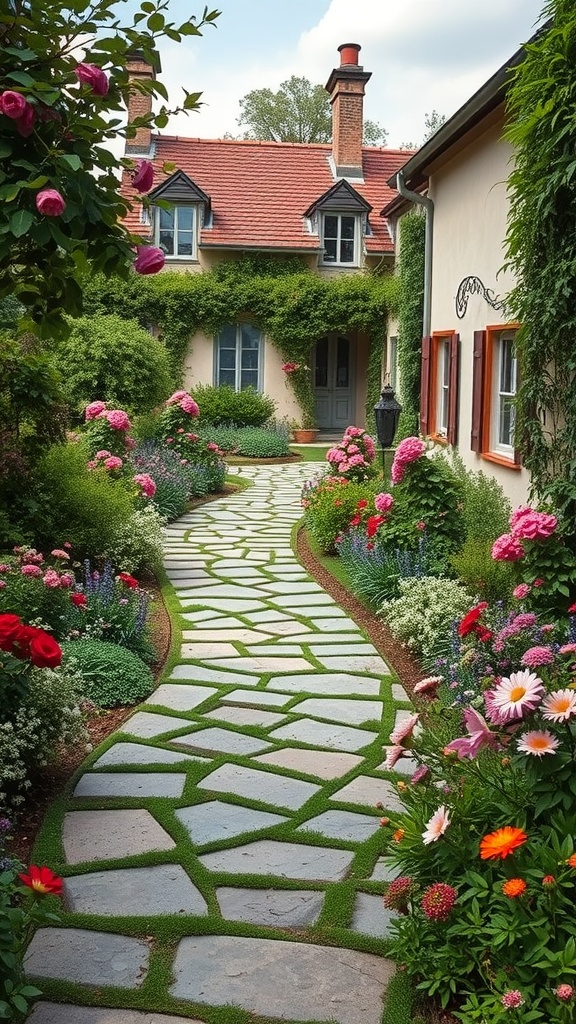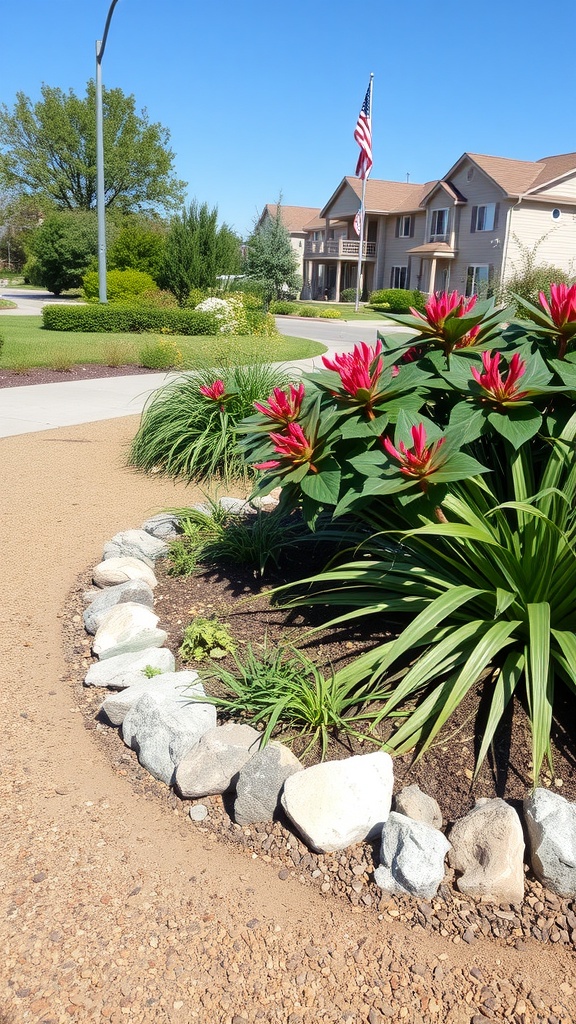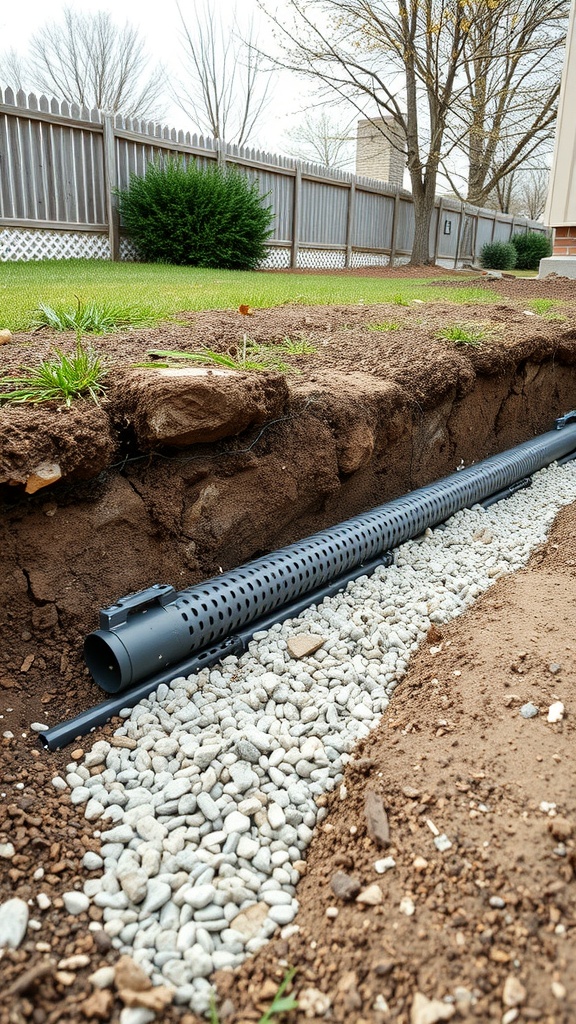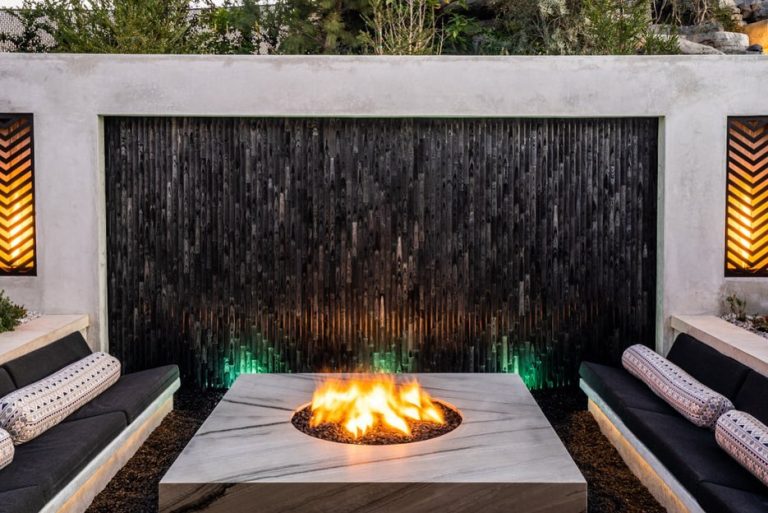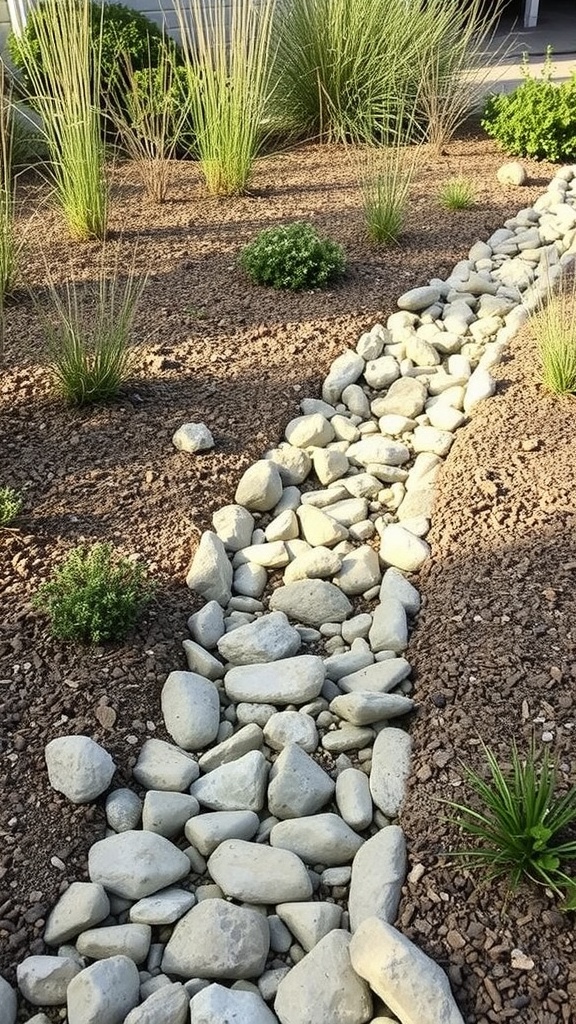19 Creative French Drain Ideas for Your Landscape
French drains are a fantastic solution for managing water flow and preventing flooding in your yard. With a variety of styles and designs to choose from, these ideas can help you tackle excess water with a blend of functionality and creativity. Check out these 19 French drain ideas that can turn a practical necessity into an attractive feature for your outdoor space.
Decorative French Drain Solutions
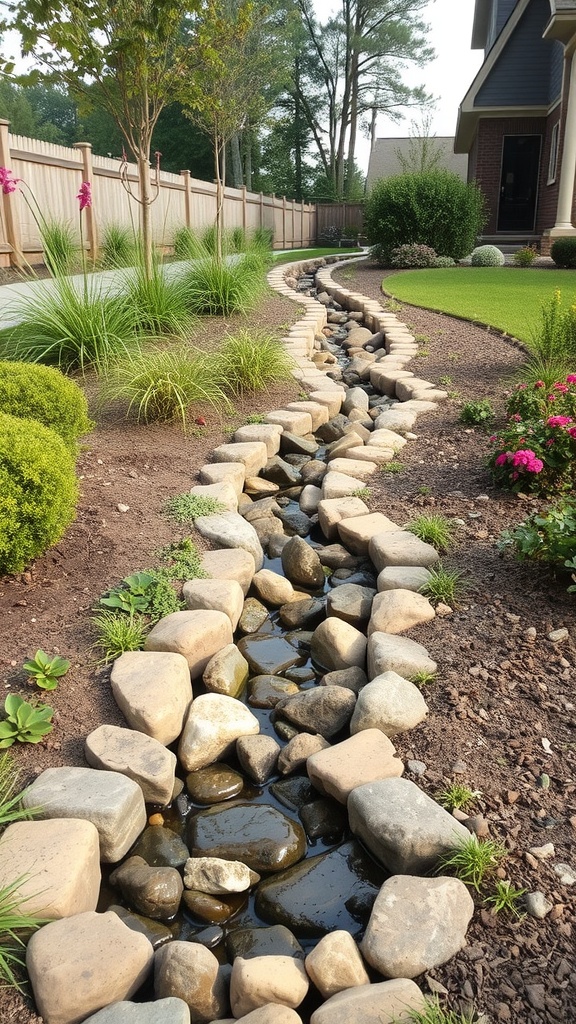
French drains are not just functional; they can also be a stylish addition to your landscape. The image shows a beautifully designed French drain that blends seamlessly with the surrounding garden. The stones create a natural look, guiding water away while enhancing the outdoor aesthetic.
Using larger rocks along the edges adds a rustic charm. This design not only serves its purpose but also complements the greenery and flowers nearby. The gentle curve of the drain mimics the natural flow of water, making it visually appealing.
Incorporating plants around the drain can soften the look even more. Grasses and colorful flowers can frame the drain, making it a focal point in your yard. This approach turns a practical solution into a decorative feature that enhances your outdoor space.
Integrating French Drains with Landscaping

French drains can be a stylish and functional addition to your garden. The image shows a beautifully landscaped area where the drain is seamlessly integrated into the design. This setup not only helps manage water flow but also enhances the overall look of the space.
The winding path of the drain is lined with attractive pavers, creating a neat border. Colorful flowers and lush greenery surround the drain, making it blend in rather than stand out. This is a great example of how drainage solutions can be both practical and visually appealing.
When planning your landscaping, think about how a French drain can fit into your design. You can use it to direct water away from problem areas while adding to the beauty of your garden. With a little creativity, you can turn a necessary feature into a stunning focal point.
French Drain with Catch Basin
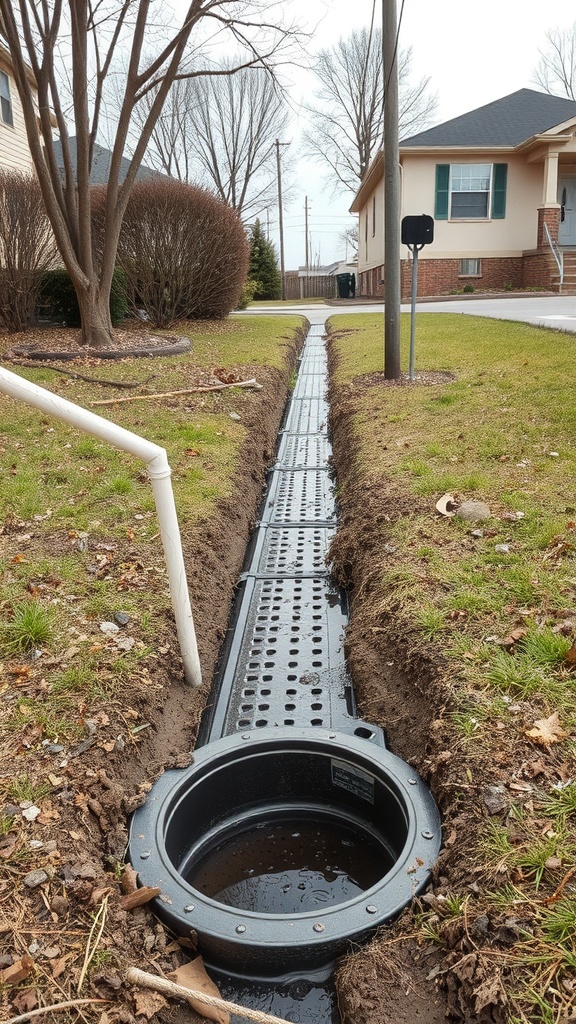
A French drain with a catch basin is a smart solution for managing excess water in your yard. The image shows a well-installed French drain that runs alongside a home, featuring a catch basin at one end. This setup helps collect and redirect water away from your foundation, preventing flooding and water damage.
The catch basin acts as a reservoir, capturing water that flows into the drain. This is especially useful during heavy rains when water can accumulate quickly. The perforated pipe allows water to enter while filtering out debris, ensuring smooth drainage.
Incorporating a French drain with a catch basin can enhance your landscape’s functionality. It not only protects your home but also keeps your yard looking neat. Plus, it can be a DIY project if you’re up for it!
French Drain in a Slope
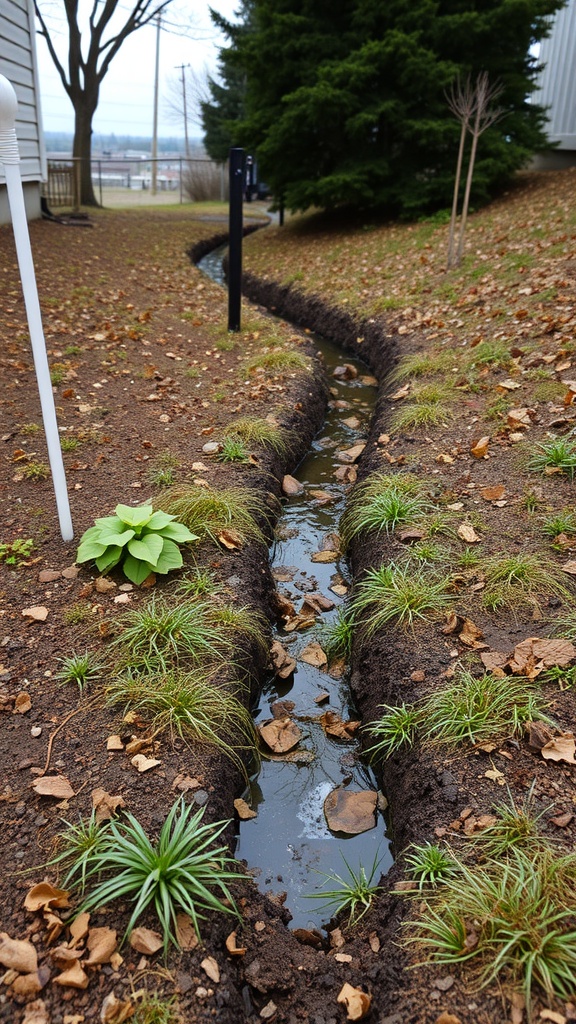
When dealing with water drainage on a slope, a French drain can be a lifesaver. The image shows a well-constructed French drain running along a sloped area. This design helps redirect water away from your home and prevents flooding.
The trench is lined with gravel and has a slight slope, allowing water to flow smoothly. You can see some grass and leaves around, which adds a natural touch to the setup. This blend of functionality and aesthetics is key for outdoor spaces.
Installing a French drain in a slope is a smart choice for homeowners. It not only protects your foundation but also keeps your yard looking great. Plus, it’s a relatively simple DIY project if you’re up for it!
Traditional French Drain Installation
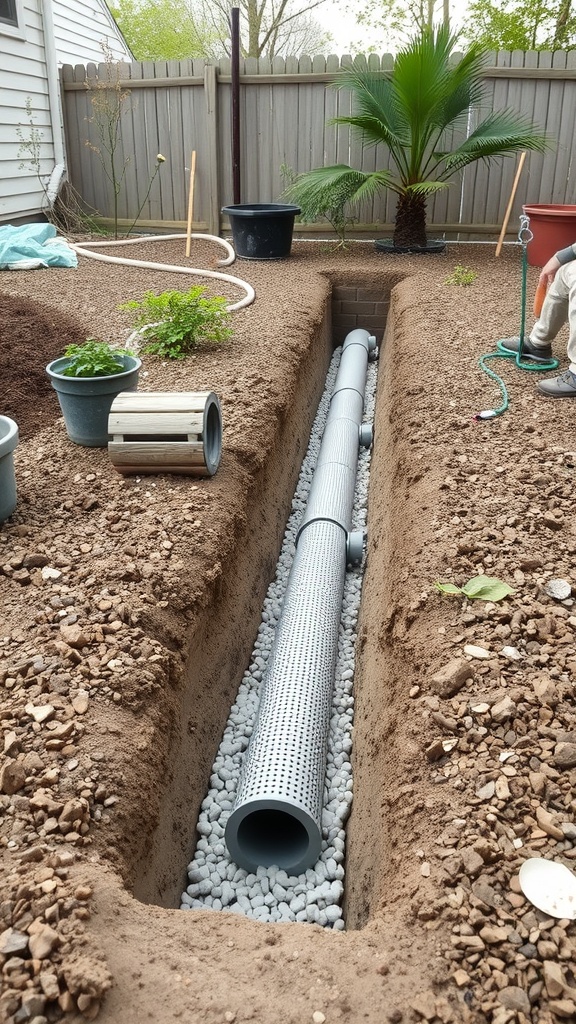
In this image, we see a traditional French drain installation taking shape. The trench is neatly dug, revealing a perforated pipe that will help manage water flow. Surrounding the pipe, we notice a layer of gravel, which is essential for drainage. This setup is designed to redirect excess water away from areas where it can cause damage.
The trench is lined with soil, showing that the installation is in progress. Nearby, there are potted plants and tools, indicating that the area is being prepared for landscaping. This combination of functionality and aesthetics is a key aspect of a well-planned French drain.
Installing a French drain like this one can prevent water pooling in your yard, protecting your plants and foundation. It’s a practical solution that blends seamlessly into the landscape.
French Drain for Basement Waterproofing
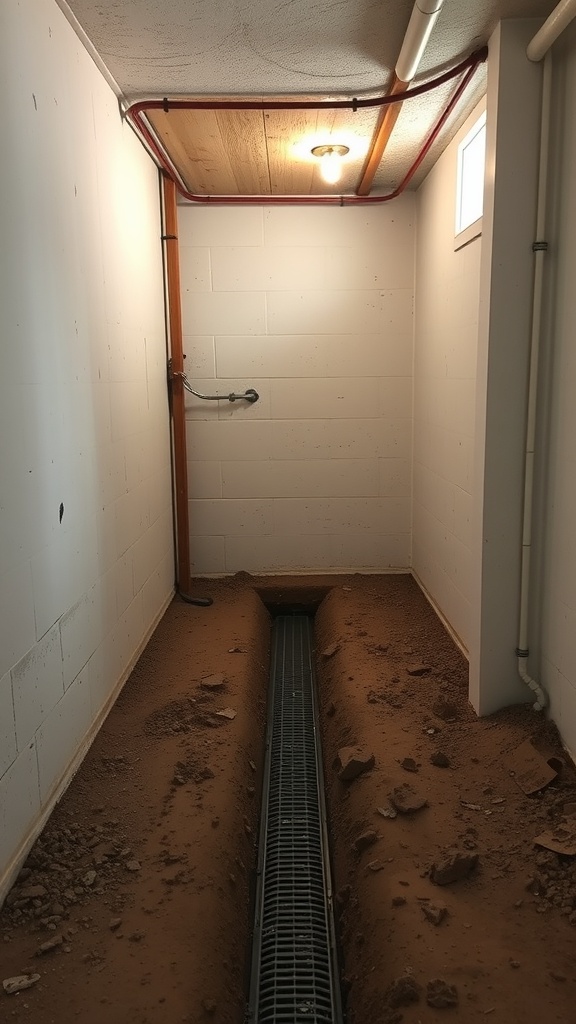
When it comes to keeping your basement dry, a French drain is a solid choice. The image shows a trench with a grate, designed to channel water away from your home. This setup is crucial for preventing water buildup, especially in areas prone to heavy rainfall.
The trench collects excess water and directs it to a drainage system, ensuring that your basement stays dry and usable. You can see the clean lines of the drain, which indicate a well-planned installation.
Using a French drain can save you from costly water damage and mold issues. It’s a straightforward solution that fits into various basement designs. If you’re considering options for basement waterproofing, a French drain is worth looking into.
DIY French Drain Techniques
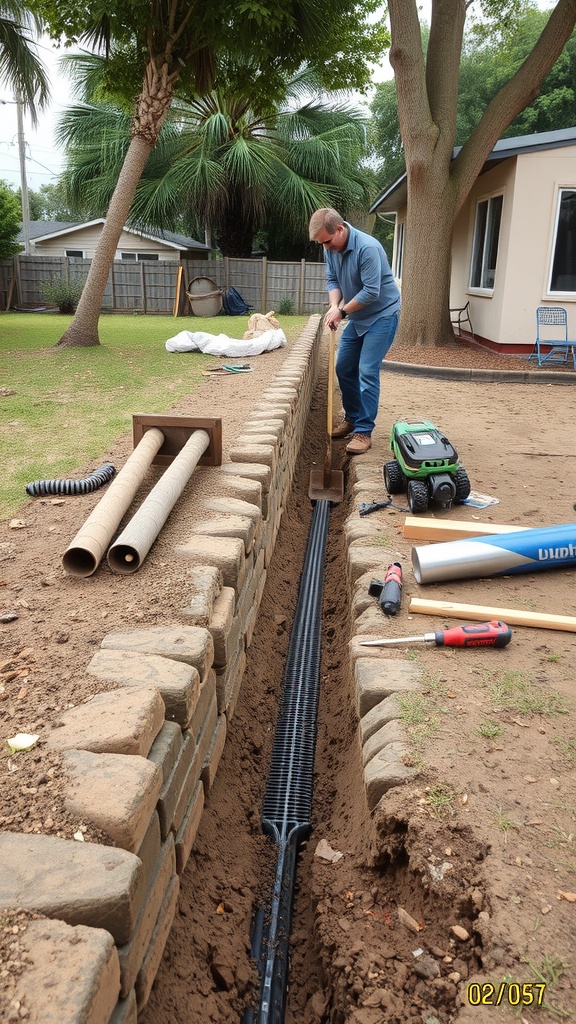
Creating a French drain can be a rewarding DIY project. The image shows a person working on a French drain installation. They are digging a trench and laying down a drainage system, which is essential for managing water flow in your yard.
In this setup, you can see the black drainage pipe positioned in the trench. This pipe helps redirect excess water away from your home, preventing flooding and water damage. The surrounding bricks provide a sturdy structure, ensuring that the drain remains effective over time.
To get started on your own French drain, you’ll need some basic tools like a shovel, a level, and the drainage materials. The process involves digging a trench, laying the pipe, and covering it with gravel for optimal drainage. It’s a straightforward task that can significantly improve your yard’s water management.
French Drain Maintenance Tips
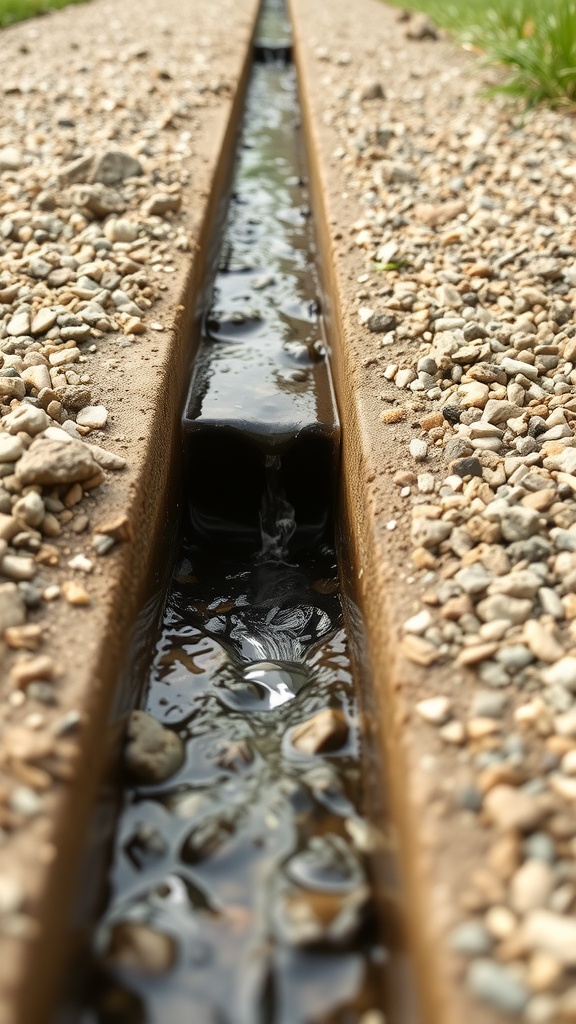
Maintaining a French drain is key to keeping your yard dry and preventing water damage. The image shows a well-constructed French drain, with water flowing smoothly through the channel. This setup is designed to direct excess water away from your home, making it essential for effective drainage.
Regularly check the drain for any blockages. Leaves, dirt, and debris can accumulate over time, hindering water flow. A quick inspection can save you from bigger issues down the line.
Another tip is to keep the surrounding area clear. Trim back any plants or grass that might encroach on the drain. This helps maintain a clear path for water to flow freely.
Consider cleaning the drain at least once a year. You can use a garden hose to flush out any buildup. If you notice persistent issues, it might be time to consult a professional.
Lastly, ensure that the outlet of the drain is functioning properly. Water should flow away from your home and not pool in one area. Keeping an eye on these details will help your French drain work effectively for years to come.
Cost Considerations for French Drains
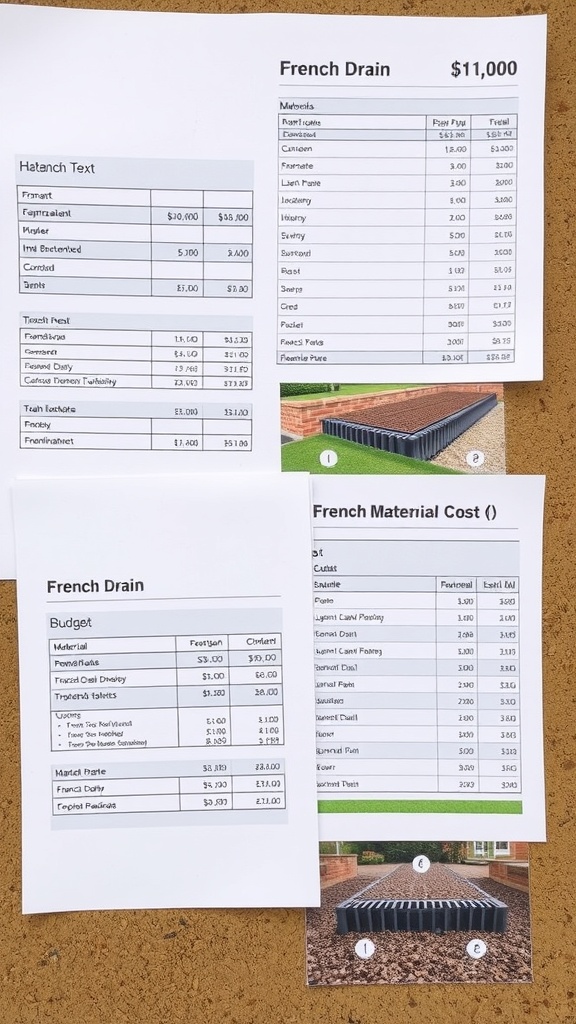
When planning a French drain, understanding the costs involved is key. The image shows a breakdown of various expenses associated with installing a French drain. The total cost is listed at $11,000, which includes materials and labor.
The materials section details different components like gravel, pipe, and fittings, each with its own price. For instance, the cost of the pipe is highlighted, showing how these small expenses can add up. The budget also outlines labor costs, which can vary based on the complexity of the installation.
It’s important to consider these factors when budgeting for your project. The image provides a clear view of the overall financial commitment needed for a successful installation. By planning ahead, you can avoid surprises and ensure that your French drain serves its purpose effectively.
French Drain in Heavy Rain Areas
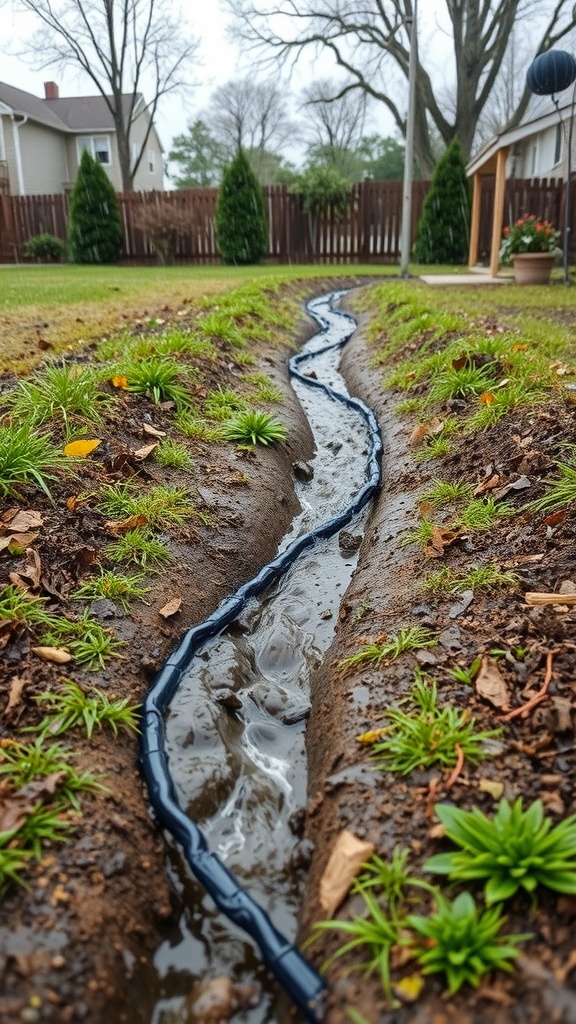
When living in areas prone to heavy rain, a French drain can be a lifesaver. This image showcases a well-installed French drain, designed to manage excess water effectively. The drain is visible as a trench filled with gravel and a perforated pipe, allowing water to flow away from your property.
In heavy rain, water can quickly accumulate, leading to flooding and damage. The French drain directs this water away, preventing pooling and protecting your home’s foundation. The gentle curve of the drain in the image illustrates how it can blend into your yard while still doing its job.
Using a French drain not only keeps your yard dry but also helps maintain the health of your landscaping. The greenery around the drain shows that it can coexist with your garden, ensuring that plants thrive while managing water flow.
For those considering a French drain, it’s essential to plan its placement carefully. The goal is to channel water away from areas where it tends to collect. With the right setup, you can enjoy your outdoor space without worrying about heavy rains.
French Drain Design for Patios
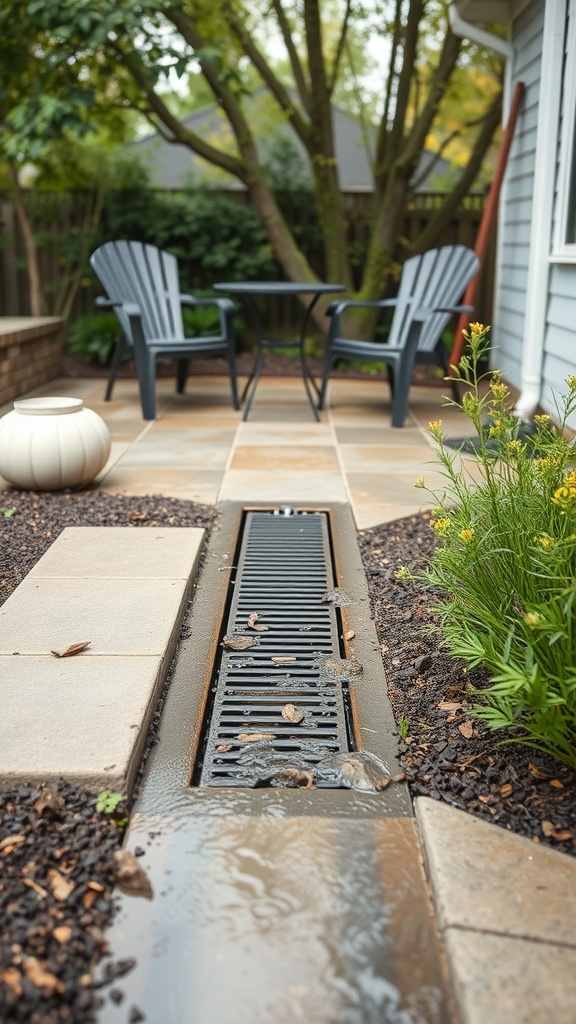
When it comes to patios, a well-designed French drain can be a lifesaver. The image shows a sleek and functional French drain running through a beautifully paved patio area. This setup not only looks good but also serves a practical purpose.
The drain helps manage water runoff, preventing puddles and potential flooding. It’s especially useful in areas with heavy rainfall. The design integrates seamlessly with the patio, allowing for both style and function.
Incorporating a French drain can enhance your outdoor space. It keeps the area dry, making it more enjoyable for gatherings. Plus, it protects your patio from water damage over time. Consider adding plants or decorative elements around the drain to blend it into your patio’s design.
Using French Drains to Prevent Erosion
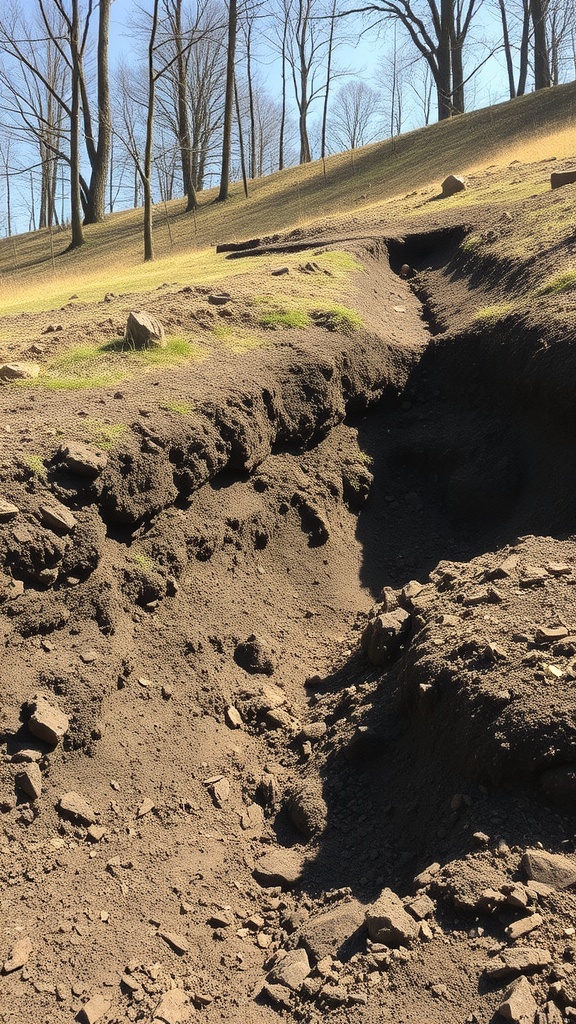
French drains are a smart way to manage water and prevent erosion. The image shows a trench that has been dug out, likely to install a French drain. This type of drainage system helps redirect water away from areas where it can cause damage, like hillsides or gardens.
In the picture, you can see the raw earth and stones, which indicate that the ground has been disturbed for this purpose. The slope in the background suggests that water runoff could be an issue here. By installing a French drain, homeowners can protect their property from the effects of erosion, keeping soil in place and preventing water from pooling.
Using a French drain is not just practical; it can also enhance the landscape. With proper installation, these drains can blend into the environment, making them a functional yet unobtrusive solution. So, if you’re dealing with erosion, consider how a French drain might help keep your yard intact.
French Drain Alternatives
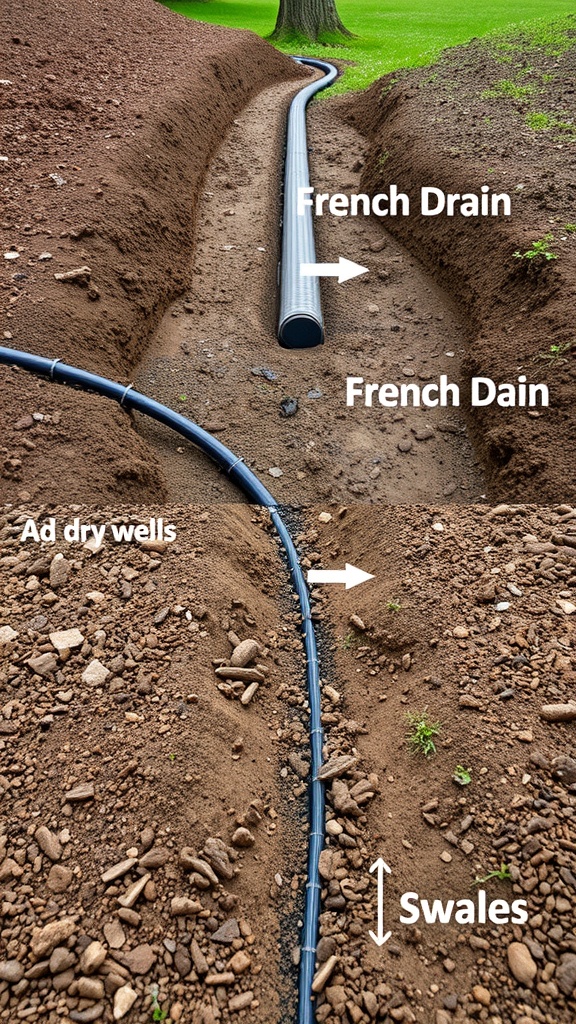
When it comes to managing water drainage, French drains are popular, but there are other options worth considering. The image shows a French drain system, which consists of a perforated pipe laid in a trench filled with gravel. This setup helps redirect water away from areas where it can cause damage.
One alternative is the use of dry wells. These are underground structures that collect and store excess water, allowing it to slowly seep into the surrounding soil. They work well in areas with high water tables or where drainage is a concern.
Swales are another great option. These are shallow, grassy channels designed to direct water runoff. They can be quite effective in managing stormwater and preventing erosion. Swales can also enhance the landscape, making them a visually appealing choice.
Considering these alternatives can help you find the best solution for your drainage needs. Each option has its benefits, and the right choice depends on your specific situation.
Innovative French Drain Systems

French drains are a smart solution for managing water flow around your home. The image shows a sleek, modern French drain system running alongside a house. This design not only serves a practical purpose but also enhances the overall look of the yard.
The drain features a slotted cover that allows water to flow in while keeping debris out. This keeps the system functioning well and reduces maintenance. The gravel surrounding the drain helps with drainage and adds a natural touch to the landscape.
Incorporating a French drain like this can prevent water pooling in your yard, which can lead to larger issues like foundation damage. It’s a simple yet effective way to protect your home while maintaining an attractive outdoor space.
Combining French Drains with Rain Gardens
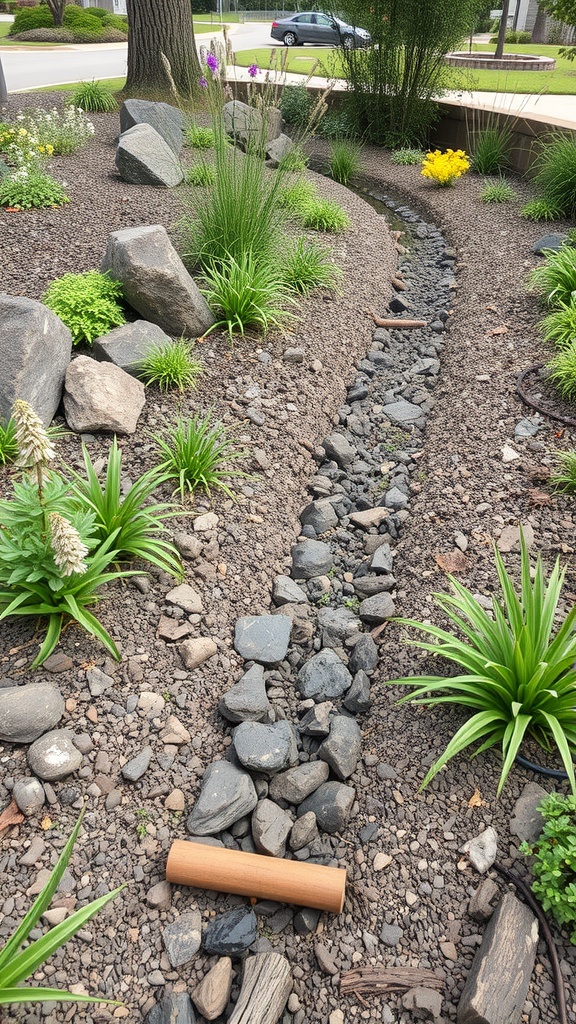
Combining French drains with rain gardens creates a beautiful and functional landscape. The image shows a well-designed rain garden featuring a gentle slope and a variety of plants. This setup helps manage water runoff effectively.
The French drain, often hidden beneath the surface, directs excess water away from areas where it can cause problems. In the image, you can see the smooth stones lining the drainage path, which not only aids in water flow but also adds a natural look.
Rain gardens are designed to absorb rainwater, which is essential for maintaining healthy plants. The colorful flowers and lush greenery in the garden enhance the aesthetic appeal while serving a practical purpose. This combination helps prevent erosion and promotes biodiversity.
Using native plants in your rain garden can further improve its effectiveness. They require less maintenance and are better suited to local conditions. Overall, this combination of French drains and rain gardens is a smart choice for anyone looking to enhance their outdoor space.

